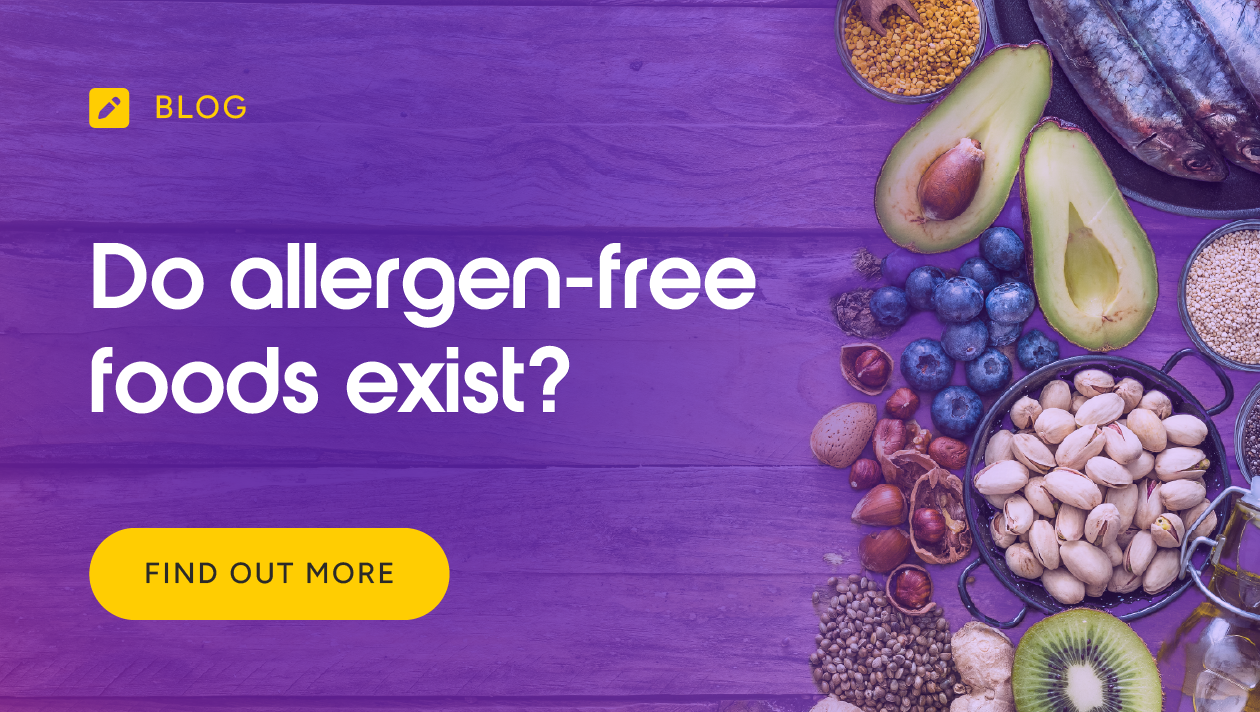Do allergen-free foods exist?
Posted 2 years ago

If you work with food, you’ll know how important it is to make sure your allergens are listed clearly before being served to customers. It’s a key part of being a responsible business!
Avoiding cross contamination, offering allergen-free alternatives, and taking care to inform your customers on what they’re eating are all vital parts to staying legally compliant and morally sound as a service provider.
We know that customer safety is your biggest priority! Without their loyalty and trust, your business wouldn’t be what it is today.
That’s why good food hygiene standards are so important when it comes to keeping your customers safe. In this blog, we’ll look at different types of allergen-free foods, and how food hygiene measures can help safeguard both your customers and your business.
Why do food allergies occur?
If you don’t suffer from any allergies whatsoever, then you can count yourself lucky!
It’s estimated that around 2 million people in the UK have a diagnosed food allergy, with many more likely to be living undiagnosed or misdiagnosed. Globally, that figure reaches up to 250 million, according to the World Allergy Organisation.
Annoyingly, allergies can occur at any point in your life. You can be born with them, but they can also develop later for seemingly no reason at all.
A food allergy causes the immune system to react differently to certain food types. The body mistakes protein molecules in the food as harmful and releases chemicals like histamine to fight the perceived threat. This reaction causes symptoms ranging from mild (e.g. itching or rashes) to severe (e.g. difficulty breathing or anaphylaxis).
But why does this happen? Unfortunately, that’s something scientists are still working to fully understand. It’s believed that genetics, environmental factors, gut health, and early exposure to allergens all play a part in some way – we’re just not entirely sure what way, yet.
As a food business, even if the science is still evolving, your responsibilities are clear. You’ve got to know what the major allergens are, manage the risk of cross-contamination, and provide transparent allergen information to your customers.
For people with lots of allergies, it can feel like a constant task to try and find food that’s allergen-free. But that in itself poses the question: does allergen-free food exist at all? Or will there always be something that someone will react to? And how do businesses help manage these risks and keep people safe?
Let’s take a look…
The most common food allergies
Although the food market is populated with thousands of dishes and ingredients, the majority of allergies stem from a select few food types. These are referred to as the “major allergens” and must legally be declared on food labels or menus.
Children are most likely to suffer from a food allergy to the following:
- Eggs
- Peanuts
- Fish
- Milk
- Shellfish (including shrimp, crab, lobster and prawns)
- Tree nuts (such as almonds, walnuts, hazelnuts and cashews)
Similarly, adults are most prone to develop allergies from some of the above, but wheat, fruit (especially apples, peaches, and kiwis), celery, and mustard are also considered high-risk.
The Food Standards Agency outlines 14 allergens that must be declared when used as ingredients. These include the items above, along with others such as soya, lupin, and sesame seeds. You can find the full list in our dedicated blog on the 14 food allergens.
Allergen-free food – what does it mean?
You’ve likely been asked by a customer if you have any gluten-free options available. Or, if you’re a business that specialises in baked goods, perhaps you’ve been asked if you serve egg-free cakes or brownies. These are two common examples of what we call allergen-free foods.
Because each allergen is unique to every individual, it’s impossible to offer a blanket definition of ‘allergy-free’ that covers the dietary requirements of all. Allergen-free describes any type of food that contains zero allergens relevant to a specific person or group.
In the UK, you’re legally required to provide clear, accurate allergen information on every food product you sell. It doesn’t matter whether the food’s packaged, unpackaged, sold in-store, or delivered to a customer’s home.
With the rise in allergen-related incidents, particularly in the tragic case of Natasha Ednan-Laperouse, consumer trust now depends heavily on how transparent and safe your processes are. Offering allergen-free foods is part of being a trustworthy, inclusive food business.
Different types of allergy-free foods
Catering for all types of dietary requirements is a must. It’s a surefire way to appeal to a wider customer base, which helps your business to grow. Lots of eateries and food businesses now offer dedicated menus that feature allergen-free dishes.
Below, we’ve compiled a list of different food types and ingredients that you can incorporate into your menu, with additional tips on preparation and safety.
Vegetables
A great source of nutrition and health, most vegetables are decently allergen-free. Whilst they can cause issues for some people, they’re a generally safe option for most, either cooked or raw.
Get creative with your selections by offering dishes that include:
- Spinach
- Kale
- Cauliflower
- Sweet potatoes
- Carrots
- Courgettes
- Butternut squash
Avoid ready-made vegetable mixes or pre-seasoned veg, as these may contain hidden allergens.
Gluten-free grains
Many types of grain contain gluten, which is considered an allergen. However, there are plenty of alternatives that are naturally gluten-free and safe for coeliacs or gluten-sensitive customers:
- Rice (brown, white, wild)
- Corn
- Quinoa
- Buckwheat (despite the name, it’s gluten-free)
- Millet
- Sorghum
Always prepare these grains in separate equipment to prevent cross-contamination with gluten-containing grains, such as rye, barley or wheat.
Legumes
Natural legumes are considered allergen-free for most people and are gluten-free too. However, they may trigger allergies in some (especially peanuts and soy, which are also legumes). Stick to the less allergenic varieties, like:
- Black beans
- Green peas
- Lentils
- Chickpeas
- Butter beans
Use unprocessed, canned, or dried versions where possible and always double-check for any allergen warnings.
Dairy alternatives
The boom in dairy-free milk alternatives means there are so many options to choose from, catering to those with lactose intolerance or milk allergies. These include:
- Coconut milk
- Oat milk (make sure it’s certified gluten-free)
- Rice milk
- Hemp milk
- Pea milk
Be cautious with almond or soy milk, as both are listed as allergens. Clearly label all alternatives to avoid confusion.
Proteins and meats
Unlike fish and shellfish (which are allergens), most meats are free of allergens in their raw form. Safe protein sources include:
- Chicken
- Turkey
- Beef
- Pork
- Lamb
Watch out for processed meats such as sausages, ham, and deli slices, which may contain hidden allergens like milk, gluten, or sulphites.
Other allergy-friendly foods include:
- Fresh fruits (apples, bananas, berries—though some fruits like kiwis may cause reactions in sensitive individuals and people with pollen allergies)
- Pure oils (olive oil, sunflower oil—avoid nut-based oils unless clearly labelled)
- Unsweetened applesauce or mashed banana as baking substitutes
When serving these foods, preparation is just as important as ingredient choice. Cross-contamination is the biggest risk.
Cross-contamination and allergies
While you can’t control cross-contamination away from your business, you can deploy food hygiene standards that prevent it from happening in your food preparation areas. This is key to keeping your allergen-free foods truly allergen-free.
Some practical measures include:
- Clean and disinfect all surfaces thoroughly: Especially worktops, chopping boards, and shared utensils. Even small amounts of an allergen can cause a reaction, so it’s vital to eliminate any residue that could transfer to allergen-free food. Regular cleaning reduces the risk of accidental contamination between meals.
- Use separate equipment for preparing and cooking allergen-free dishes: Have colour-coded chopping boards or dedicated kitchen tools. This helps prevent allergens from being introduced through knives, pans, or boards that were previously used for ingredients containing allergens. It’s a straightforward way to keep preparation processes safe and consistent.
- Provide appropriate clothing: Use disposable gloves and aprons for staff preparing allergen-free meals. Clothing can carry allergens from one task to another, so disposable or dedicated items help maintain a barrier. Gloves and aprons also show staff and customers that you’re taking extra care.
- Label food items and equipment clearly: Prevent mix-ups by marking containers, shelves, and even utensils. Clear labelling makes it easy to identify which items are allergen-free, reducing the chance of human error, especially during busy shifts when things can easily get muddled.
- Train all staff: Make sure both front and back-of-house staff understand allergen procedures and what to do if something goes wrong. Training makes sure that everyone is on the same page and aware of how serious allergic reactions can be. Well-informed staff are more likely to follow procedures correctly and respond appropriately if a mistake occurs.
What to do if cross-contamination occurs
Even with the most rigorous processes in place, no kitchen is immune to human error. Cross-contamination can happen, and when it does, how your team responds is key. Acting quickly and transparently can reduce the risk to the customer, demonstrate your commitment to food safety, and help prevent similar mistakes in the future.
If cross-contamination is suspected:
- Inform the customer immediately and offer an alternative if it’s safe to do so. Recommend medical attention if any reaction occurs.
- Don’t serve the dish unless you’re 100% confident it’s allergen-free. If in doubt, throw the dish out and make a new one.
- Log the incident internally and carry out a root-cause analysis (RCA) to prevent it from happening again. Specific details will need to be logged, such as the staff involved, the time of the incident and the potential cross-contamination sources.
- Review your procedures and retrain staff if necessary. You can retrain your staff on specific food hygiene courses or allergen awareness training.
Being transparent with your procedures and immediately taking action helps protect your staff and customers, and also helps build a stronger level of trust.
The tragic death of Natasha Ednan-Laperouse
One of the most impactful real-world examples of why allergen awareness matters is the case of 15-year-old Natasha Ednan-Laperouse.
Natasha died in 2016 after eating a baguette from Pret A Manger that contained sesame seeds – an ingredient that wasn’t listed on the packaging. This led to the creation of Natasha’s Law, which came into effect in 2021.
Under Natasha’s Law, all pre-packed for direct sale (PPDS) foods must have a full ingredients list with allergens emphasised. This law has fundamentally changed how food businesses label products and raised the importance of allergen safety across the UK. It also helped to show that even large suppliers, such as Pret, are still vulnerable to allergen mistakes, and that due diligence is important no matter the size of your business.
Discover more about food allergies with our courses
Now you understand a bit more about allergen-free foods, why not increase your knowledge with one of our dedicated online courses?
Our Food Allergy Awareness Training course offers a deeper insight into the different types of food allergens and how to manage risks effectively for your business.
We also offer the following online courses and bundles that cover food safety, offering you an interactive training delivery to help your business and staff grow:
- Food Hygiene Level 1 Online Course
- Food Hygiene Level 2 Online Course
- Food Hygiene Level 3 Online Course
- Food Hygiene Levels 1-3 Course Package
So, ready to get started? Claim your free, no-obligation trial to any of our courses today or request a bespoke quote and a member of our team will be in touch to discuss your training needs!
Related articles



Opt-in to our newsletter
Receive industry news & offers